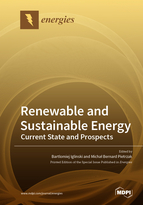Renewable and Sustainable Energy: Current State and Prospects
A special issue of Energies (ISSN 1996-1073). This special issue belongs to the section "A3: Wind, Wave and Tidal Energy".
Deadline for manuscript submissions: closed (25 March 2022) | Viewed by 40036
Special Issue Editors
Interests: renewable energy; environmental conservation; sustainable energy; pro-ecological technologies
Special Issues, Collections and Topics in MDPI journals
Interests: renewable energy; sustainable development; low-emission economy; regional analysis
Special Issues, Collections and Topics in MDPI journals
Special Issue Information
Dear Colleagues,
Energy is the essential engine of economic development and a factor in improving the quality of life. Reliable access to energy is a key element of economic and social development. Conventional fuel resources are limited and non-renewable and their use contributes to the pollution of the atmosphere with greenhouse gases, which causes a constantly increasing climate warming. Therefore, it is necessary to intensify the production of energy from renewable energy (RE) sources. Importantly, each type of RE should be obtained in a sustainable way, because only in this way can the energy transformation be carried out. The development of the RE fosters a decentralized society, powered by a network of smaller and safer power plants, and the strengthening of local communities.
This Special Issue is about the current state, potential, and perspectives of renewable and sustainable energy development. Research is being conducted around the world on the improvement of individual sectors of the RE. As a result, technologies related to the production of RE are characterized by increasing energy efficiency, with a simultaneous decrease in the costs of their purchase and installation. There are also favorable socio-economic aspects of scientific and technological development, such as the improvement of the quality of life and new jobs. This Special Issue will feature the latest scientific, technical, and economic developments in renewable and sustainable energy.
Topics of interest for publication include, but are not limited to, the following:
- Possibilities of RE development
- Biomass technology and biofuels applications
- Biogas and biomethane production
- Wind energy technology
- Solar thermal and photovoltaic technology
- Hydropower technology, wave, tide, and ocean thermal energies
- Geothermal technology
- Hydrogen production and fuel cells
- Proecological aspects in the energy sector
- Institutional and mental determinants of RE sector
- Primary fuels, energy, and renewable energy market
- Energy transformation, prosumers
- Low-emission economy, decarbonization strategy
- Socio-economic consequences of the development of the RE sector
Dr. Bartlomiej Iglinski
Prof. Dr. Michal Bernard Pietrzak
Guest Editors
Manuscript Submission Information
Manuscripts should be submitted online at www.mdpi.com by registering and logging in to this website. Once you are registered, click here to go to the submission form. Manuscripts can be submitted until the deadline. All submissions that pass pre-check are peer-reviewed. Accepted papers will be published continuously in the journal (as soon as accepted) and will be listed together on the special issue website. Research articles, review articles as well as short communications are invited. For planned papers, a title and short abstract (about 100 words) can be sent to the Editorial Office for announcement on this website.
Submitted manuscripts should not have been published previously, nor be under consideration for publication elsewhere (except conference proceedings papers). All manuscripts are thoroughly refereed through a single-blind peer-review process. A guide for authors and other relevant information for submission of manuscripts is available on the Instructions for Authors page. Energies is an international peer-reviewed open access semimonthly journal published by MDPI.
Please visit the Instructions for Authors page before submitting a manuscript. The Article Processing Charge (APC) for publication in this open access journal is 2600 CHF (Swiss Francs). Submitted papers should be well formatted and use good English. Authors may use MDPI's English editing service prior to publication or during author revisions.
Keywords
- renewable and sustainable energy
- renewable energy sources
- energy conversion
- proecological technologies
- low-emission economy







